Constitutional Law: Amendments, Rights, Discrimination Analysis
VerifiedAdded on 2023/06/03
|8
|1422
|116
Homework Assignment
AI Summary
This assignment provides a comprehensive analysis of various constitutional rights and amendments in the United States. It begins by examining key amendments such as the 1st, 4th, 5th, and 6th, focusing on freedom of religion, protection from unreasonable searches, and rights of the accused. The assignment delves into the Lemon Test, Brandenburg vs. Ohio case concerning inflammatory speech, and the concept of symbolic speech. It further explains due process, including procedural aspects and its relation to the exclusionary rule, as well as the rights of the accused. The discussion extends to rational basis review, strict scrutiny, de facto and de jure discrimination, affirmative action, and the Bakke vs. California case. Finally, it highlights the importance of the Voting Rights Act of 1965 and the Civil Rights Act of 1968 in protecting against racial discrimination in voting and housing. The document provides a detailed overview of constitutional law principles and landmark cases, offering valuable insights into the legal framework protecting individual rights and equality.

Name of the Student
Name of the Professor
City/State
Date/Month/Year
Name of the Professor
City/State
Date/Month/Year
Paraphrase This Document
Need a fresh take? Get an instant paraphrase of this document with our AI Paraphraser
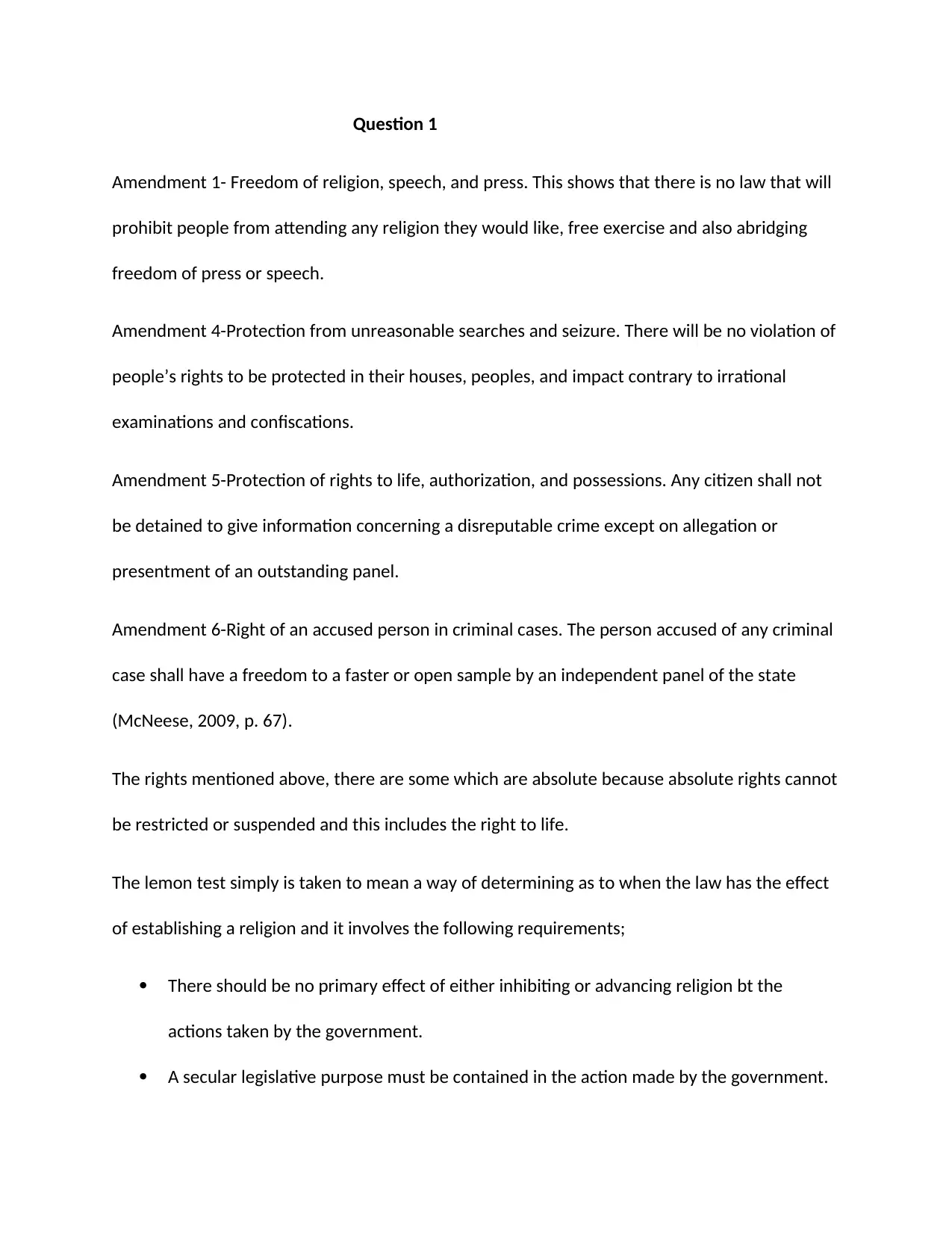
Question 1
Amendment 1- Freedom of religion, speech, and press. This shows that there is no law that will
prohibit people from attending any religion they would like, free exercise and also abridging
freedom of press or speech.
Amendment 4-Protection from unreasonable searches and seizure. There will be no violation of
people’s rights to be protected in their houses, peoples, and impact contrary to irrational
examinations and confiscations.
Amendment 5-Protection of rights to life, authorization, and possessions. Any citizen shall not
be detained to give information concerning a disreputable crime except on allegation or
presentment of an outstanding panel.
Amendment 6-Right of an accused person in criminal cases. The person accused of any criminal
case shall have a freedom to a faster or open sample by an independent panel of the state
(McNeese, 2009, p. 67).
The rights mentioned above, there are some which are absolute because absolute rights cannot
be restricted or suspended and this includes the right to life.
The lemon test simply is taken to mean a way of determining as to when the law has the effect
of establishing a religion and it involves the following requirements;
There should be no primary effect of either inhibiting or advancing religion bt the
actions taken by the government.
A secular legislative purpose must be contained in the action made by the government.
Amendment 1- Freedom of religion, speech, and press. This shows that there is no law that will
prohibit people from attending any religion they would like, free exercise and also abridging
freedom of press or speech.
Amendment 4-Protection from unreasonable searches and seizure. There will be no violation of
people’s rights to be protected in their houses, peoples, and impact contrary to irrational
examinations and confiscations.
Amendment 5-Protection of rights to life, authorization, and possessions. Any citizen shall not
be detained to give information concerning a disreputable crime except on allegation or
presentment of an outstanding panel.
Amendment 6-Right of an accused person in criminal cases. The person accused of any criminal
case shall have a freedom to a faster or open sample by an independent panel of the state
(McNeese, 2009, p. 67).
The rights mentioned above, there are some which are absolute because absolute rights cannot
be restricted or suspended and this includes the right to life.
The lemon test simply is taken to mean a way of determining as to when the law has the effect
of establishing a religion and it involves the following requirements;
There should be no primary effect of either inhibiting or advancing religion bt the
actions taken by the government.
A secular legislative purpose must be contained in the action made by the government.
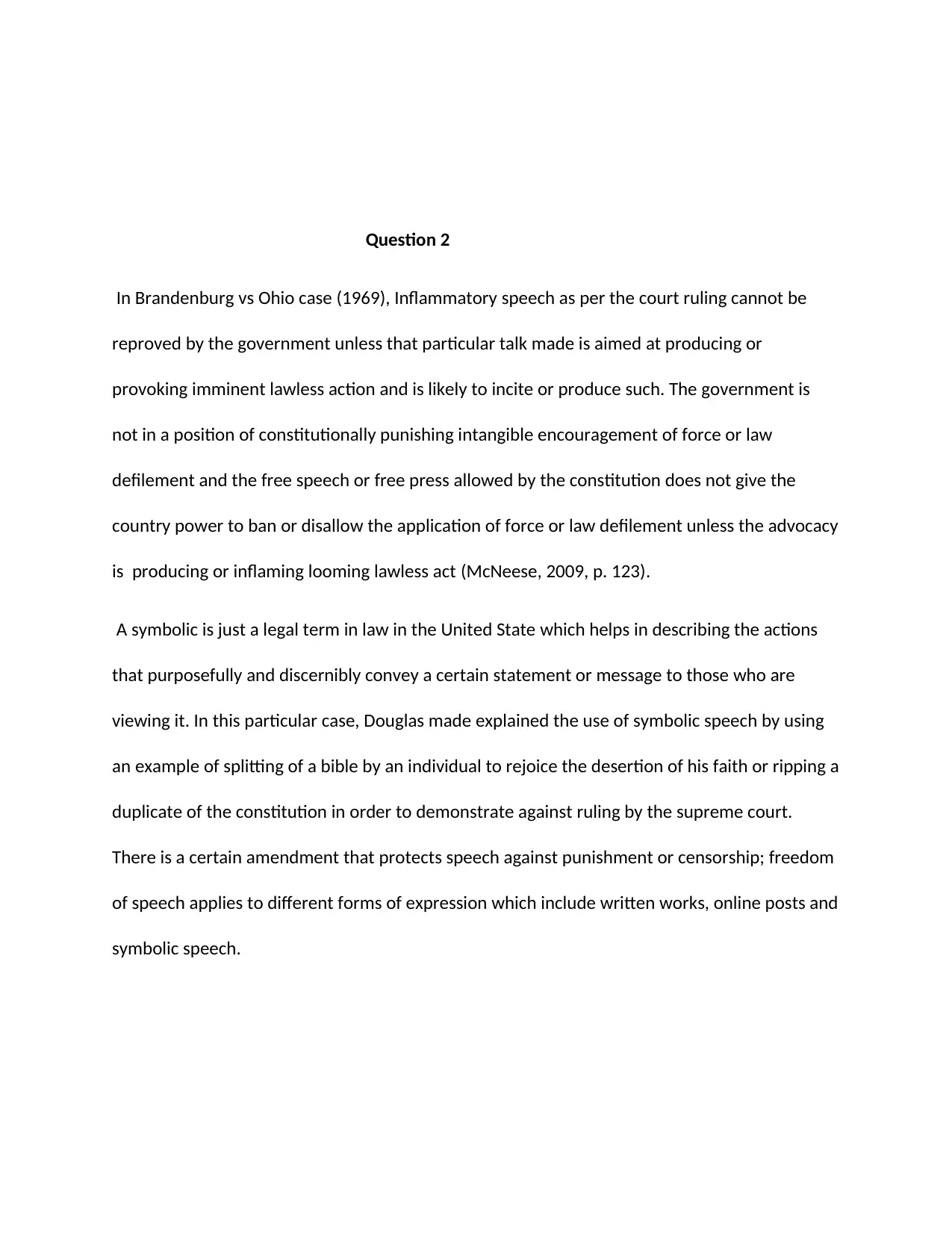
Question 2
In Brandenburg vs Ohio case (1969), Inflammatory speech as per the court ruling cannot be
reproved by the government unless that particular talk made is aimed at producing or
provoking imminent lawless action and is likely to incite or produce such. The government is
not in a position of constitutionally punishing intangible encouragement of force or law
defilement and the free speech or free press allowed by the constitution does not give the
country power to ban or disallow the application of force or law defilement unless the advocacy
is producing or inflaming looming lawless act (McNeese, 2009, p. 123).
A symbolic is just a legal term in law in the United State which helps in describing the actions
that purposefully and discernibly convey a certain statement or message to those who are
viewing it. In this particular case, Douglas made explained the use of symbolic speech by using
an example of splitting of a bible by an individual to rejoice the desertion of his faith or ripping a
duplicate of the constitution in order to demonstrate against ruling by the supreme court.
There is a certain amendment that protects speech against punishment or censorship; freedom
of speech applies to different forms of expression which include written works, online posts and
symbolic speech.
In Brandenburg vs Ohio case (1969), Inflammatory speech as per the court ruling cannot be
reproved by the government unless that particular talk made is aimed at producing or
provoking imminent lawless action and is likely to incite or produce such. The government is
not in a position of constitutionally punishing intangible encouragement of force or law
defilement and the free speech or free press allowed by the constitution does not give the
country power to ban or disallow the application of force or law defilement unless the advocacy
is producing or inflaming looming lawless act (McNeese, 2009, p. 123).
A symbolic is just a legal term in law in the United State which helps in describing the actions
that purposefully and discernibly convey a certain statement or message to those who are
viewing it. In this particular case, Douglas made explained the use of symbolic speech by using
an example of splitting of a bible by an individual to rejoice the desertion of his faith or ripping a
duplicate of the constitution in order to demonstrate against ruling by the supreme court.
There is a certain amendment that protects speech against punishment or censorship; freedom
of speech applies to different forms of expression which include written works, online posts and
symbolic speech.
⊘ This is a preview!⊘
Do you want full access?
Subscribe today to unlock all pages.

Trusted by 1+ million students worldwide

Question 3
Due process entails running of justice thus the clause on the due process offers protection from
subjective denial of life, freedom or possessions by the administration freestanding the
approval of the law. The procedural due process needs a fair process to be followed by the
officials in government afore divesting a person of liberty, life or possessions. A person should
be given time to express him or herself at a minimum person through a neutral person before a
person to be denied those particular interests. Criminal procedural due process include;
An inscribed notification to the inmate to check mental illness.
A hearing after giving the prisoner a notice and the evidence is looked upon.
A chance at trial to provide the testament of eyewitnesses and face the witness.
A liberated decision maker.
An inscribed declaration by the factfinder showing the proof relied upon.
Accessibility of legal counsel.
Effective and well-timed notice of all foregoing rights.
The due process relates to exclusionary rule such a legal procedure is followed to prevent the
analyzed or collected evidence to be used in violating the defendant's constitutional rights. The
rights of the accused related to the due process clause such that the suspect enjoy the right to a
speedy and public process following a legal procedure. The due process and good faith
exclusion may be defensible relying on the quarter alteration’s flexible prohibition on irrational
examinations and confiscations.
Question 4
Due process entails running of justice thus the clause on the due process offers protection from
subjective denial of life, freedom or possessions by the administration freestanding the
approval of the law. The procedural due process needs a fair process to be followed by the
officials in government afore divesting a person of liberty, life or possessions. A person should
be given time to express him or herself at a minimum person through a neutral person before a
person to be denied those particular interests. Criminal procedural due process include;
An inscribed notification to the inmate to check mental illness.
A hearing after giving the prisoner a notice and the evidence is looked upon.
A chance at trial to provide the testament of eyewitnesses and face the witness.
A liberated decision maker.
An inscribed declaration by the factfinder showing the proof relied upon.
Accessibility of legal counsel.
Effective and well-timed notice of all foregoing rights.
The due process relates to exclusionary rule such a legal procedure is followed to prevent the
analyzed or collected evidence to be used in violating the defendant's constitutional rights. The
rights of the accused related to the due process clause such that the suspect enjoy the right to a
speedy and public process following a legal procedure. The due process and good faith
exclusion may be defensible relying on the quarter alteration’s flexible prohibition on irrational
examinations and confiscations.
Question 4
Paraphrase This Document
Need a fresh take? Get an instant paraphrase of this document with our AI Paraphraser
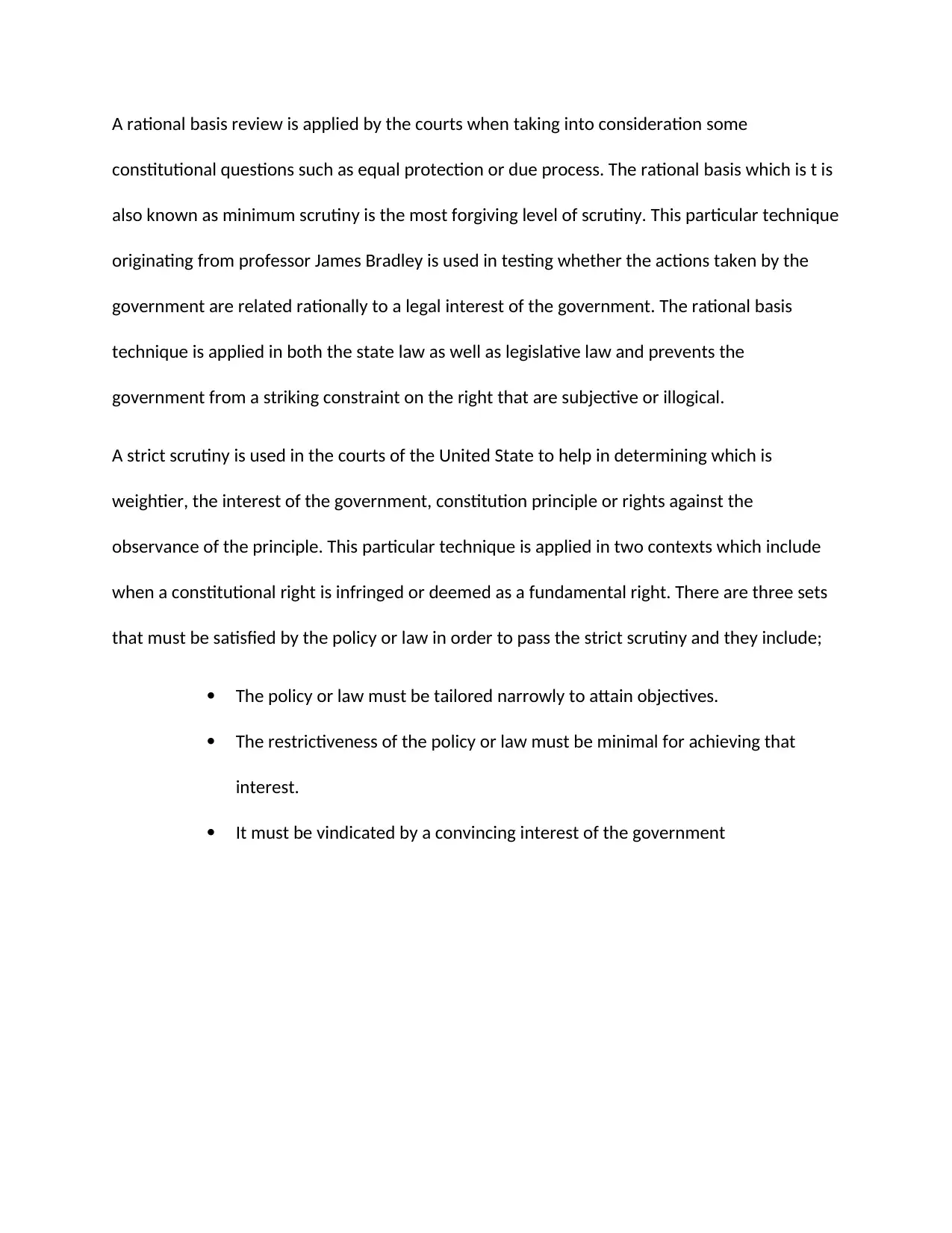
A rational basis review is applied by the courts when taking into consideration some
constitutional questions such as equal protection or due process. The rational basis which is t is
also known as minimum scrutiny is the most forgiving level of scrutiny. This particular technique
originating from professor James Bradley is used in testing whether the actions taken by the
government are related rationally to a legal interest of the government. The rational basis
technique is applied in both the state law as well as legislative law and prevents the
government from a striking constraint on the right that are subjective or illogical.
A strict scrutiny is used in the courts of the United State to help in determining which is
weightier, the interest of the government, constitution principle or rights against the
observance of the principle. This particular technique is applied in two contexts which include
when a constitutional right is infringed or deemed as a fundamental right. There are three sets
that must be satisfied by the policy or law in order to pass the strict scrutiny and they include;
The policy or law must be tailored narrowly to attain objectives.
The restrictiveness of the policy or law must be minimal for achieving that
interest.
It must be vindicated by a convincing interest of the government
constitutional questions such as equal protection or due process. The rational basis which is t is
also known as minimum scrutiny is the most forgiving level of scrutiny. This particular technique
originating from professor James Bradley is used in testing whether the actions taken by the
government are related rationally to a legal interest of the government. The rational basis
technique is applied in both the state law as well as legislative law and prevents the
government from a striking constraint on the right that are subjective or illogical.
A strict scrutiny is used in the courts of the United State to help in determining which is
weightier, the interest of the government, constitution principle or rights against the
observance of the principle. This particular technique is applied in two contexts which include
when a constitutional right is infringed or deemed as a fundamental right. There are three sets
that must be satisfied by the policy or law in order to pass the strict scrutiny and they include;
The policy or law must be tailored narrowly to attain objectives.
The restrictiveness of the policy or law must be minimal for achieving that
interest.
It must be vindicated by a convincing interest of the government
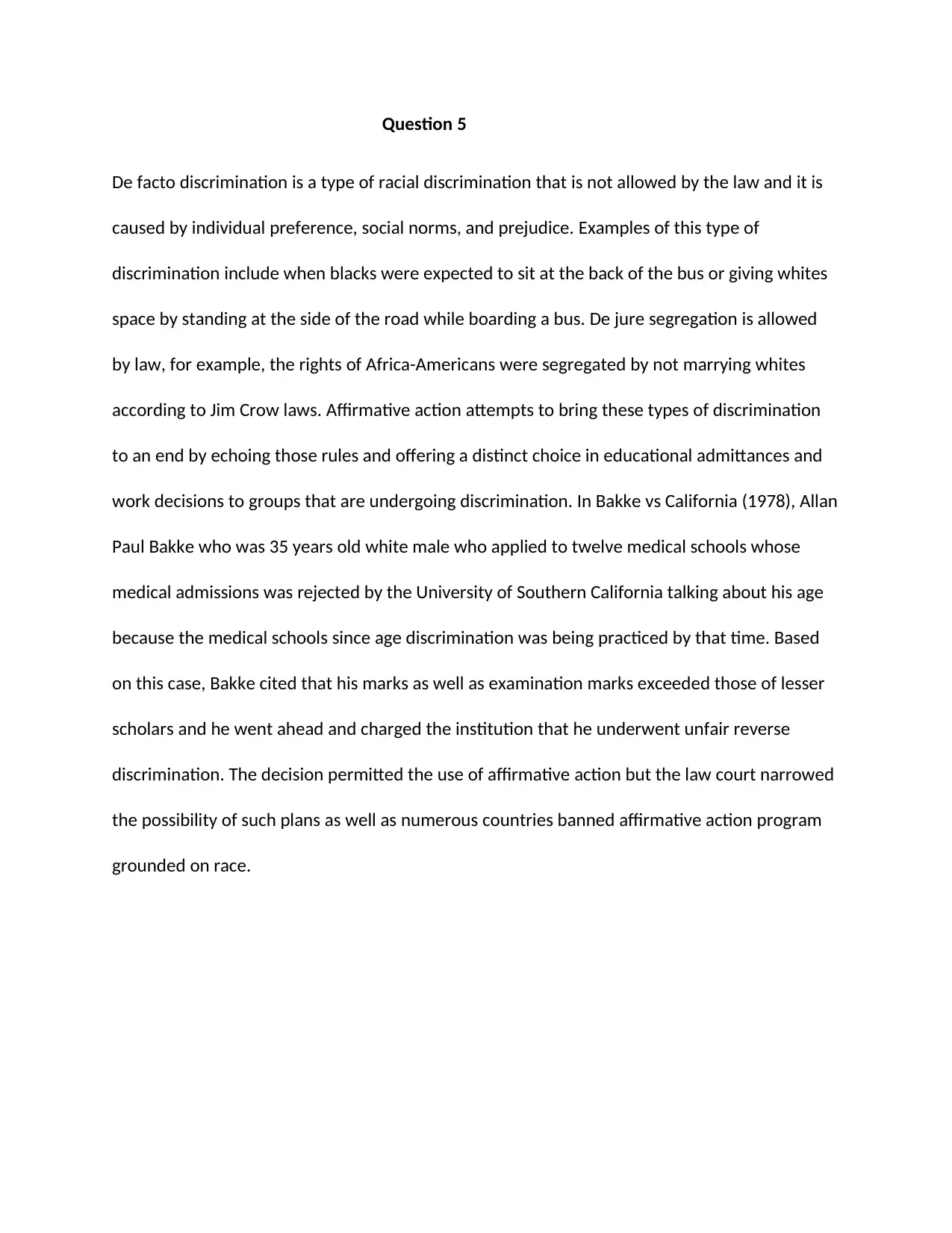
Question 5
De facto discrimination is a type of racial discrimination that is not allowed by the law and it is
caused by individual preference, social norms, and prejudice. Examples of this type of
discrimination include when blacks were expected to sit at the back of the bus or giving whites
space by standing at the side of the road while boarding a bus. De jure segregation is allowed
by law, for example, the rights of Africa-Americans were segregated by not marrying whites
according to Jim Crow laws. Affirmative action attempts to bring these types of discrimination
to an end by echoing those rules and offering a distinct choice in educational admittances and
work decisions to groups that are undergoing discrimination. In Bakke vs California (1978), Allan
Paul Bakke who was 35 years old white male who applied to twelve medical schools whose
medical admissions was rejected by the University of Southern California talking about his age
because the medical schools since age discrimination was being practiced by that time. Based
on this case, Bakke cited that his marks as well as examination marks exceeded those of lesser
scholars and he went ahead and charged the institution that he underwent unfair reverse
discrimination. The decision permitted the use of affirmative action but the law court narrowed
the possibility of such plans as well as numerous countries banned affirmative action program
grounded on race.
De facto discrimination is a type of racial discrimination that is not allowed by the law and it is
caused by individual preference, social norms, and prejudice. Examples of this type of
discrimination include when blacks were expected to sit at the back of the bus or giving whites
space by standing at the side of the road while boarding a bus. De jure segregation is allowed
by law, for example, the rights of Africa-Americans were segregated by not marrying whites
according to Jim Crow laws. Affirmative action attempts to bring these types of discrimination
to an end by echoing those rules and offering a distinct choice in educational admittances and
work decisions to groups that are undergoing discrimination. In Bakke vs California (1978), Allan
Paul Bakke who was 35 years old white male who applied to twelve medical schools whose
medical admissions was rejected by the University of Southern California talking about his age
because the medical schools since age discrimination was being practiced by that time. Based
on this case, Bakke cited that his marks as well as examination marks exceeded those of lesser
scholars and he went ahead and charged the institution that he underwent unfair reverse
discrimination. The decision permitted the use of affirmative action but the law court narrowed
the possibility of such plans as well as numerous countries banned affirmative action program
grounded on race.
⊘ This is a preview!⊘
Do you want full access?
Subscribe today to unlock all pages.

Trusted by 1+ million students worldwide
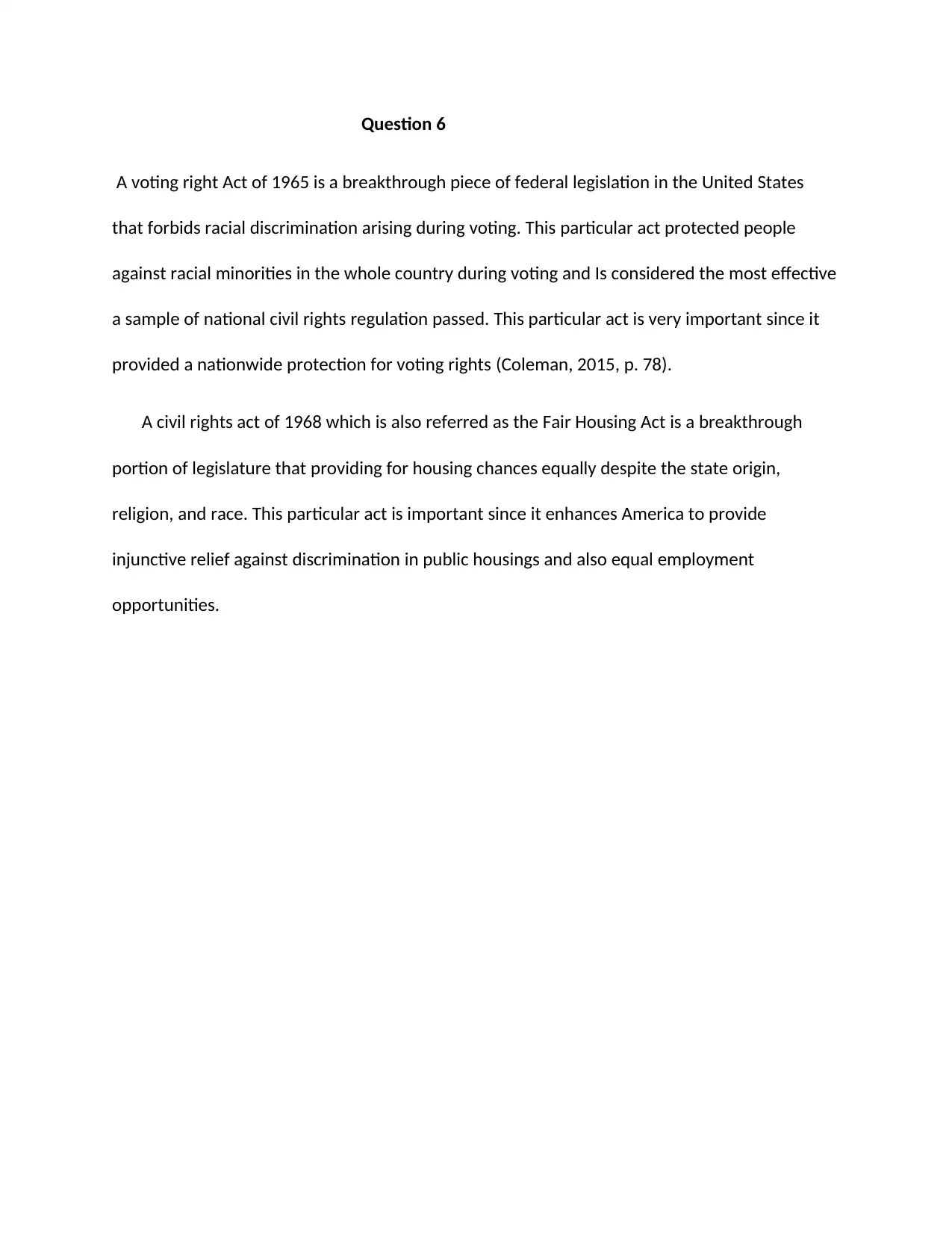
Question 6
A voting right Act of 1965 is a breakthrough piece of federal legislation in the United States
that forbids racial discrimination arising during voting. This particular act protected people
against racial minorities in the whole country during voting and Is considered the most effective
a sample of national civil rights regulation passed. This particular act is very important since it
provided a nationwide protection for voting rights (Coleman, 2015, p. 78).
A civil rights act of 1968 which is also referred as the Fair Housing Act is a breakthrough
portion of legislature that providing for housing chances equally despite the state origin,
religion, and race. This particular act is important since it enhances America to provide
injunctive relief against discrimination in public housings and also equal employment
opportunities.
A voting right Act of 1965 is a breakthrough piece of federal legislation in the United States
that forbids racial discrimination arising during voting. This particular act protected people
against racial minorities in the whole country during voting and Is considered the most effective
a sample of national civil rights regulation passed. This particular act is very important since it
provided a nationwide protection for voting rights (Coleman, 2015, p. 78).
A civil rights act of 1968 which is also referred as the Fair Housing Act is a breakthrough
portion of legislature that providing for housing chances equally despite the state origin,
religion, and race. This particular act is important since it enhances America to provide
injunctive relief against discrimination in public housings and also equal employment
opportunities.
Paraphrase This Document
Need a fresh take? Get an instant paraphrase of this document with our AI Paraphraser
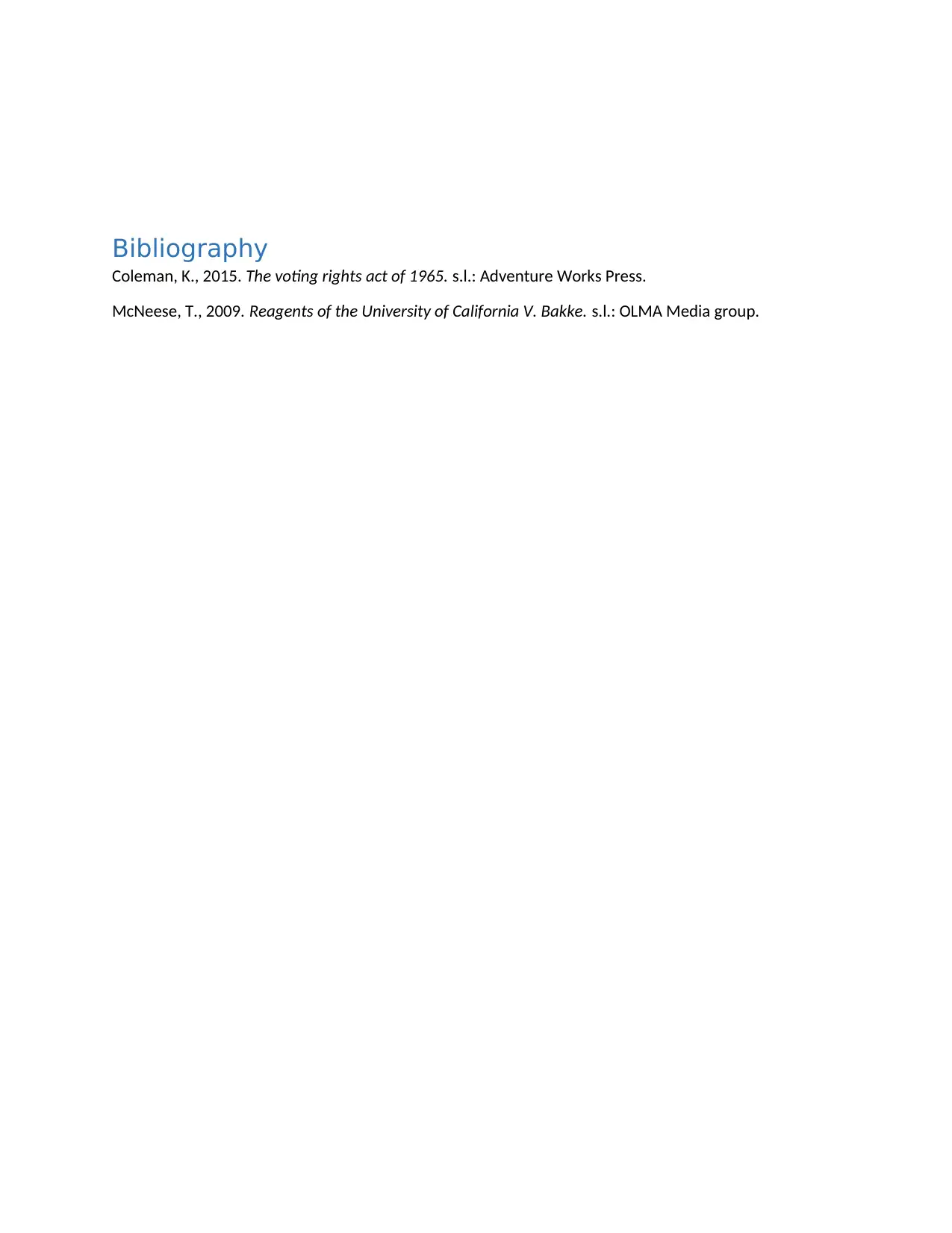
Bibliography
Coleman, K., 2015. The voting rights act of 1965. s.l.: Adventure Works Press.
McNeese, T., 2009. Reagents of the University of California V. Bakke. s.l.: OLMA Media group.
Coleman, K., 2015. The voting rights act of 1965. s.l.: Adventure Works Press.
McNeese, T., 2009. Reagents of the University of California V. Bakke. s.l.: OLMA Media group.
1 out of 8
Related Documents
Your All-in-One AI-Powered Toolkit for Academic Success.
+13062052269
info@desklib.com
Available 24*7 on WhatsApp / Email
![[object Object]](/_next/static/media/star-bottom.7253800d.svg)
Unlock your academic potential
Copyright © 2020–2025 A2Z Services. All Rights Reserved. Developed and managed by ZUCOL.





